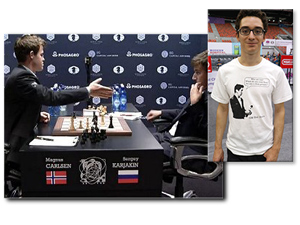


20.30 Hamburg / 14.30 New York: How many games do you play a day to practise?.
20.24 Hamburg / 14.24 New York: Here you can see the press conference after game 6.
15.38 / 9.38 am: Norwegian Grandmaster and author Jonathan Tisdall published a noteworthy piece after game eight in mattogpatt.no - food for thought.
13.34 / 7.34 am: Accoring to the Spanish Sports newspaper Marca, Carlsen is threatened to be fined with 60.000 US-Dollars for not attending the press conference after the first decisive game.
13.09 / 7.09 am: Daniel King did a round up show on playchess.com. Click here to watch it for free.
10.42 / 4.42 am: After the game Judit Polgar, official commentator for the match, offered an explanation why Carlsen risked so much in the game: "Magnus was really determined to have a decisive game today. ... He gave Sergey a lot of opportunities in this game. ... Magnus was so determined to win the game, even when it was hard to understand why he went on. He wanted to have a decisive game. The tension was so high for both players."
She then added: "But Magnus can punch back. But it is going to be extremely difficult. For both players."
10.02 / 4.02 am: The following short clip shows how Carlsen leaves the press conference.
9.19 Hamburg/ 3.19 New York: Daniel King published his analysis game 8. At 10 am /Hamburg time) you can follow his summary on playchess.com (We'll publish the video here as well).
10.15 Mumbai/ 5.45 Hamburg/ 23.45 New York: IM Sagar Shah analyzes the reason why Magnus Carlsen lost game eight. His conclusion was a clear lack of objectivity on the part of the World Champion. Full analysis and key positions explained on the ChessBase India newspage.

Sergey Karjakin is happy
1:34 / 7:34 pm: Carlsen attended the press conference for about a minute, but then got up and stormed off.


1:09 / 7:09 pm: Carlsen resigns!

1:02 / 7:02 pm: After 51...h5 Judit Polgar makes a prediction: Sergey Karjakin will win the game!
0:49 / 6.49 pm:

Carlsen is making a very unhappy impression now - he has to defend an unpleasant ending
0:45 / 6.45 pm: Karjakin is now a pawn down, but his strong knight and the passer on a3 give him more than enough compensation.
0:19 / 6.19 pm:

NOW: Double Mistake in urgency: - On the border of hazardous
0:09 / 6.09 pm: Stefan Löffler already thinks about the impact of this time trouble blunders on the upcoming games.

0:05 / 6.05 pm:

00.02 / 6.02 pm: To catch up: Carlsen took plenty of risk (35.c5) and seemingly blundered in time trouble - however Karjakin did not find the best defence, still emerges with a pawn up but has a very weak king. What a game we are having?!
23.56 / 5.56 pm:

Carlsen realizes that he has misplayed it
23.48 / 5.48 pm: Ian Nepomniachtchi already advices Carlsen to seek for some perpetual - has the world champion overpushed his luck?
23.40 / 5.40 pm:
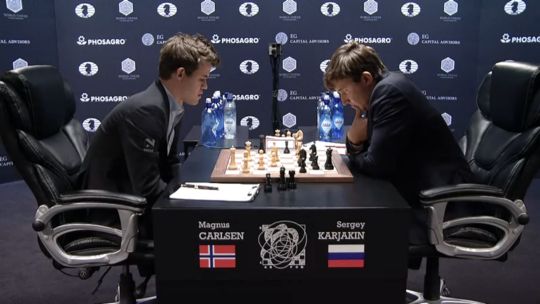
Both players are down six minutes, the tension increases as Carlsen takes further risks.
23.18 / 5.18 pm: However, his colleague Daniel King sees it optimistically.

23.04 / 5.04 pm: British Grandmaster Conquest makes a reference to Magnus' opening choice in this game:

Johannes Hermann Zukertort was a 19th century chess player who competed in the 1st official World Championship Match in 1886. He lost it to Wilhelm Steinitz.
23.04 / 5.04 pm: According to world class player Ian Nepomniachtchi the position became very drawish.
22.55 / 4.55 pm: As Polgar and Caruana, Radjabov is not impressed with Karjakin's play in this middlegame.
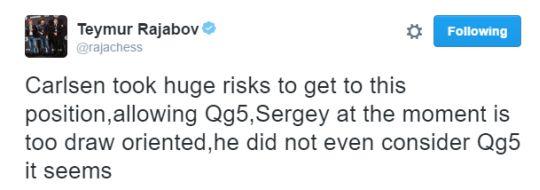
22.42 / 4.42 pm: Caruana on Sergeys 21...Bxc4: "once you give up the bishop, there is no attack" - Magnus' king is out of danger now and white has a slight advantage.
22.33 / 4.33 pm: Both players only have a bit over 30 minutes for the next 20 moves - time trouble could become an issue.

22.32 / 4.32 pm:

Current World Nr. 2 Fabiano Caruana joins the commentary team. He is not very impressed by Karjakin's maneuver Bc6 and Bd5.
22.14 / 4.14 pm:
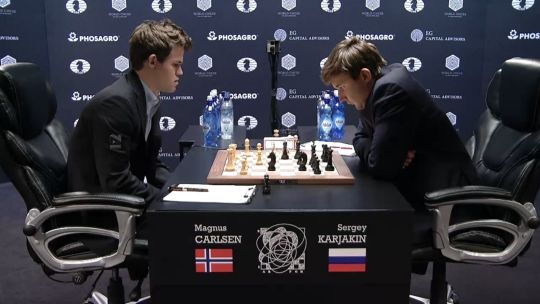
Sergey is probably trying to get through the variation jungle starting with 20...Qg5
21.55 / 3.55 pm: Magnus does not look very happy. Sergey has more time on the clock and quite promising attacking chances on the kingside.
21.51 / 3.51 pm: Jonathan Rowson is less impressed by Carlsen's maneuvers:
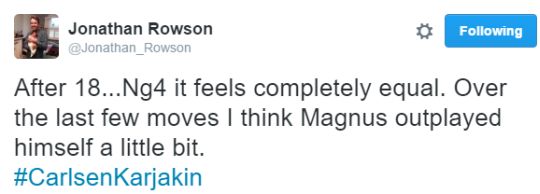
21.28 / 3.28 pm: Judit's sister Susan ist also puzzled:

21.28 / 3.28 pm: Polgar is surprised by Magnus' choice of putting the Queen to e1: "...but it can be a genius move, it's like Magnus played it"
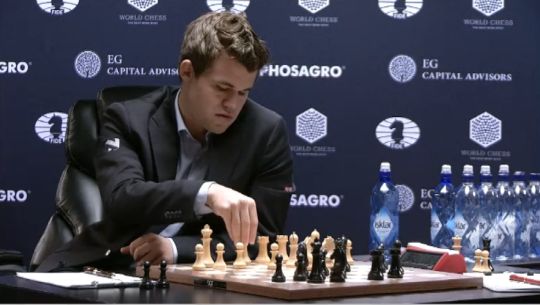
Carlsen playing 17.Qe1!?
21.02 / 3.02 pm:

20.42 / 2.42 pm: Btw, today's 1st move was carried out by astrophysicist Neil deGrasse Tyson.
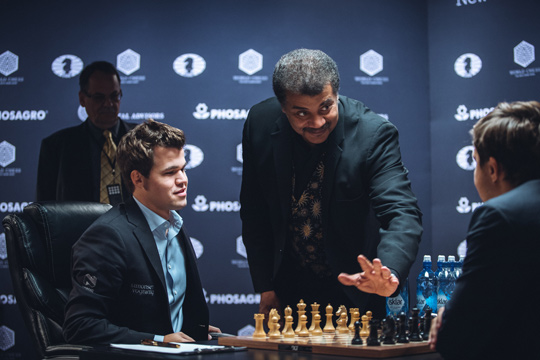
"Sergey, is d4 ok for you as well?" (Foto: Max Avdeev)
20.30 / 2.30 pm: Dutch Grandmaster Erwin l'Ami believes Sergey considers to exchange the strong bishop on d3.

20.21 / 2.21 pm: Team Carlsen continues to try sidelines - this time Zukertort!

20.21 / 2.21 pm:
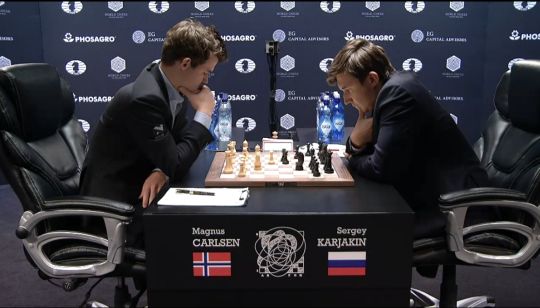
Both players seem to be highly concentrated from the beginning.
20.20 / 2.20 pm: As the opening is less forcing than the Spanish mainlines we had so far, both players take their time to figure out the best move orders. Only seven moves played so far.
20.03 / 2.03 pm: Carlsen chooses 1.d4 today, but does not opt for the Trompovsky again, instead he continues rather slow with 2.Nf3 and 3.e3 - a clear sign that he will try to avoid theory and "play a long game" (Polgar).
19.57 Hamburg / 1.57 pm New York:
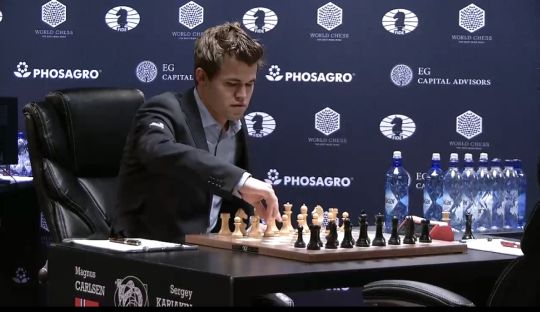
Magnus Carlsen arrives early at the board
19.53 Hamburg / 1.53 pm New York: Some minutes to go! Magnus Carlsen with the white pieces will try to put as much pressure as possible on his opponent, Judit Polgar expects a long battle.
World Chess Championship 2016 Newsblogs:
21.28 / 3.28 pm: